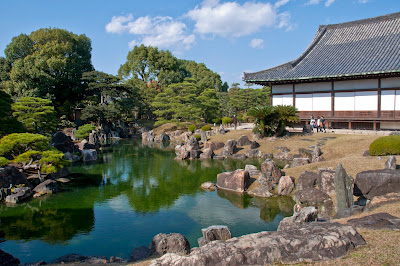Lost in Translation, Part 5: Kyoto (Part 1)
Kyoto is Japan’s ancient
capital, founded in 794. It remains the nation’s spiritual and cultural heart. They
say it’s impossible to know the real Japan without
knowing Kyoto. More than 1600 Buddhist temples and 400 Shintō shrines
intermingle with natural scenery, modern buildings, and original architecture
with affecting beauty.
Although ravaged by the
usual earthquakes, fires, and wars through the centuries, Kyoto was spared
during World War II thanks to Secretary of War Henry L. Stimson, who was adamant
that this important cultural center be preserved.
Yes, it is now in many
ways a modern city; but the myriad of temples and shrines provide perfect oases
from the hustle and bustle of metropolitan life, with their raked pebble
gardens, still lakes reflecting golden-roofed pagodas, and groves of bamboo.
Geisha in full makeup wander in and out of doorways in the Gion and Pontochō
districts. Through tiny alleys, the unique scents of Japanese cuisine fill the
air. Kyoto is the Japanese city of your Japanese dreams.
We arrived in Kyoto by
night, and the modern metropolis that greets you at the station offers very
little taste of the treasures this city holds.
We checked into the lovely
Westin Miyako and ate dinner at a local teppanyaki place where I enjoyed
yet another okonomiyaki—this one in the local style that incorporates
noodles—and my first (and last—yuck) Santori.
Our first day began with a
visit to Nijō Castle. It was built in 1603 for the first shogun of the
Edo period and is considered the best-surviving example of a feudal Japanese
castle. It’s made up of buildings, large and small, that are surrounded by
beautiful gardens—not to mention fortified walls and moats. The main building
is the Ninomaru Palace, which served as the residence and office of the shogun
during his visits to Kyoto. He was clearly a paranoid fellow: in addition to
the walls and moats, the palace has all kinds of security features. Guards with
swords at the ready stood behind hidden panels in the walls and the famous
“nightingale floors” feature floorboards that intentionally squeak whenever
stepped upon. The layout of the castle ensures that guests came only as close
to the shogun as necessary: highly ranked visitors could enter the main
audience room, but lower ranked visitors could only go as far as the adjoining
rooms with no direct view.
Ryōanji Temple (“Temple of the Dragon at Peace”) is home to
Japan's most famous rock garden. Originally an aristocrat's villa during the
Heian Period, the site was converted into a Zen temple in 1450. No one really
knows the origin of the raked pebble garden, which is a rectangular plot of
pebbles with 15 larger rocks laid out in small groups on patches of moss. The
rocks are laid out such that at least one is always hidden from view from any
vantage point. To be honest, I was underwhelmed…but overall the property had
some lovely gardens.
Kinkaku-ji (“Temple of the Golden Pavilion”), officially
named Rokuon-ji (“Deer Garden Temple”), is perhaps the most beautiful
building in all of Kyoto. The name clearly derives from the gold leaf that
enshrines its upper floors. It was built as a retirement villa by the shogun
Ashikaga Yoshimitsu, and per his wishes it was converted to a Zen temple after
his death in 1408.
The original building
suffered damage on multiple occasions, most tragically July 2, 1950, when a
mentally ill monk burned the building in an attempted suicide. It took 5 years
of meticulous work to restore its exact appearance. The interior is closed to
the public.
Kinkaku-ji is dramatically
set on a lake and surrounded by gardens of the Muromachi period, which is
considered to be the classical age of Japanese garden design. The
gardens have maintained their original design since 1408. The view of
Kinkaku-ji reflected in its lake is simply stunning, and while every season is
different it felt particularly special to be there on a beautiful autumn day
when the gold leafing reflected the setting sun and the real leaves around it
were a painter’s palette of reds and oranges. A simply unforgettable sight.
As with all temples, there
was an opportunity to light candles or incense to ask for special favor from
the gods. Here’s Karen praying for something, perhaps to “do a brisk business”.
Eikan-dō (formally called Zenrin-ji, “temple in a calm
grove”) is the head temple for the Seizan branch of Japan's Jōdo-shū
Buddhist sect. It was founded by Shinshō, a pupil of Kūkai (the founder of
Koyasan, you may recall, from my last post…see how it all comes together?!).
Like much of Kyoto, it is famous for its fall foliage and we visited at night.
On crisp fall evenings, many of Kyoto’s temples and shrines are illuminated,
with special attention paid to the spectacular autumn foliage—which really seems
to come alive when it glows against the starry night sky.
That night we headed to
the Gion district for some sushi and sake, followed by socialization at a bar
called, inexplicably, “Hello Dolly”.




























































2 Comments:
Nice post, Doug! I am dying to visit Kyoto (and Tokyo), especially now that we're out here.
By Unknown, at 7:42 PM
Unknown, at 7:42 PM
Great pics! Each one looks like a professional postcard.
By Anonymous, at 10:57 AM
Anonymous, at 10:57 AM
Post a Comment
<< Home